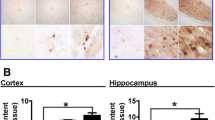Summary
Scarce information is available on the content of metals and their molecules in the human brain. Iron, copper and other metals are involved in neurodegenerative disorders like Parkinson’s Disease (PD), however, their behavior in physiological conditions is poorly understood. In this study we have measured iron, copper and their major proteins (ferritins and ceruloplasmin) in substantia nigra (SN) of normal subjects at different ages, since this is the main target region of PD. An increasing trend for iron and copper concentration was found in aging. Ferritins were also increasing in aging while ceruloplasmin did not vary. These data show that the accumulation of these metals requires an increased expression of storage molecules to prevent toxic effects of iron and copper.
Similar content being viewed by others
Author information
Authors and Affiliations
Rights and permissions
About this article
Cite this article
Zecca, L., Zucca, F., Toscani, M. et al. Iron, copper and their proteins in substantia nigra of human brain during aging. J Radioanal Nucl Chem 263, 733–737 (2005). https://doi.org/10.1007/s10967-005-0650-8
Issue Date:
DOI: https://doi.org/10.1007/s10967-005-0650-8




